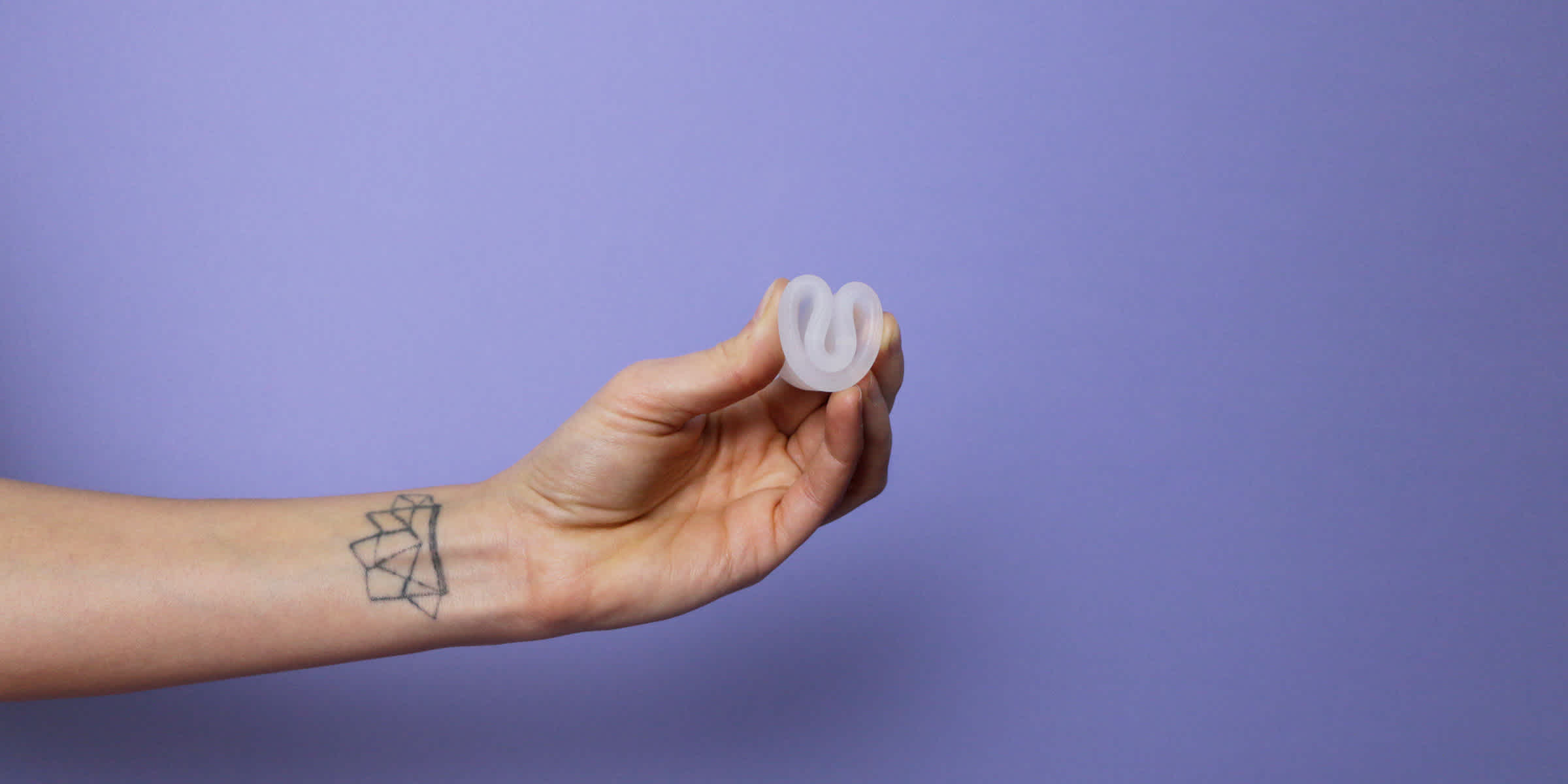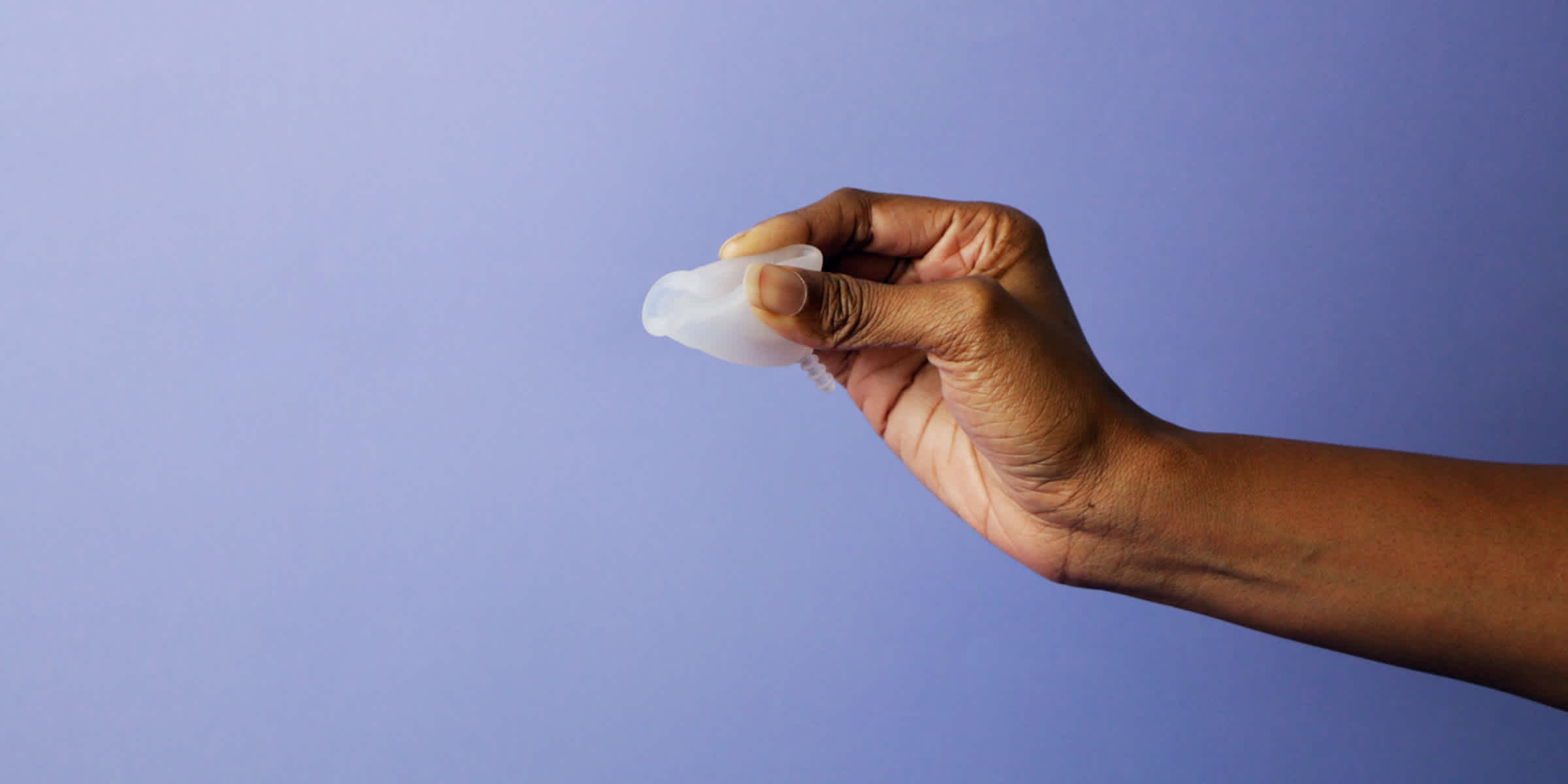Photo by Susi Vetter and Benedikt Scheckenbach
How to use a menstrual cup

Menstrual cups are a reusable collection method for menstrual fluid during your period. Although they may look daunting at first, with a little practice, using a menstrual cup is an easy, safe, environmentally-friendly, and economical way to collect menstrual blood. Don’t be intimidated by a small piece of silicone—we’re here to help, with step-by-step instructions on how to safely, comfortably, and effectively use a menstrual cup.
Preparing to use a menstrual cup
First off, you’ve got to purchase one. Since menstrual cups come in a variety of shapes and sizes, this task may seem overwhelming. Check your local pharmacy or take a look online, and see what options are available to you. Many menstrual cup sellers offer different sizes for people who are at different ages and stages of their life, different amounts of menstrual flow, or who have different anatomy. For example, for people with a low cervix, a shorter cup may be better. People who do more physical exercise may find a more rigid cup better at preventing leaks (1). Read the descriptions on the box or online to find the best menstrual cup for you.

Cleaning and disinfecting your menstrual cup
Before you use your menstrual cup for the first time (and after the end of every period), it’s important to disinfect it. This can be done quickly at home: just grab a pot, drop the menstrual cup in, add water until the menstrual cup isn’t resting on the bottom of the pot, and stick it on the stove top. Boil the menstrual cup for five minutes, and that’s it. Remove the menstrual cup from the pot and let it cool down completely before insertion (2).
While you are on your period, you do not need to disinfect your menstrual cup each time you empty it—a simple cleaning with warm water and a mild soap will be enough. Make sure you clean out the tiny holes just below the rim of the menstrual cup—these are responsible for creating suction so that blood doesn’t leak past the cup.
How to insert a menstrual cup
1. Clean
Before inserting a menstrual cup, make sure it is clean and disinfected (if it’s the start of a new cycle). Clean your hands with warm soapy water. If your fingernails are long and sharp, consider cutting them shorter, as insertion with long fingernails can be more difficult.
2. Fold:
Fold the menstrual cup so that the wide opening of the menstrual cup is made smaller for insertion. There are several ways to do this:
C-fold (aka Half fold, U-fold): Fold the top rim of your menstrual cup in half, so that it creates a tight C or U shape.

Push down fold (aka Tip fold, tulip fold): Push one side of the rim down into the cup, creating a narrow point.

3. Insert
Find a comfortable position. Try sitting on the toilet, standing, or squatting. Holding the folded menstrual cup with one hand, use your free hand to part your labia. Locate your vaginal opening, and slowly insert your menstrual cup into your vagina in the direction your tailbone. As you insert the menstrual cup, try to maintain the folded position of the menstrual cup.
4. Open
When you can no longer hold the cup in a folded position let it “pop” open inside your vagina, and continue to push the menstrual cup from the base of the cup. You should gently push the menstrual cup deep enough so that the stem is no longer protruding out of your vaginal opening. Do not push the menstrual cup so deep that you are unable to grab the stem of the cup.
5. Rotate (optional)
Once inserted, some menstrual cup instructions ask you to twist the menstrual cup to ensure that it is sealed and secure. To do this, grab the menstrual cup by the base (not stem) and give it a full rotation (3,4).
6. Check
If you are not sure if your menstrual cup has opened completely, try inserting a finger along the inside your vagina up to the rim of the menstrual cup, and follow the rim around, ensuring that the whole rim has opened up. To ensure that your menstrual cup is correctly in place and popped open, grasp the stem and gently pull on it. You want to feel some resistance or a feeling of suction pressure.
7. Wear
Once you are sure that your menstrual cup is set, you can be on your way and wear it for up to 12 hours. Some people chose to wear a small panty liner or bring an extra pad or tampon with them, just in case they experience leaks. It can take a few weeks to get used to menstrual cups, so if at first you don't succeed, try, try again. It can take a couple of attempts, but it’s worth it (2-4).
How to remove a menstrual cup
Clean: Clean your hands with warm soapy water.
Bear down: Find a comfortable position, either sitting on the toilet or squatting. Using your abdominal muscles, bear down as if you are having a bowel movement—this will help push your menstrual cup slightly down in your vagina and make it easier for grasping.
Pinch the base of the cup to break the seal:mGently pull the stem to pull the menstrual cup down the vagina until you can reach the base of the menstrual cup. Pinch the base of the cup to break the suction seal—now you will be able to remove the cup more easily.
Pull: Some people just pull the cup straight out by the stem, but this can get messy and uncomfortable. Avoid this by pulling from the pinched base. This will give you more control over the cup (less spillage on your hands) and also keep the rim of the cup in a slightly folded position, making the diameter more narrow and more comfortable for removal.
Empty: If you want to see how much menstrual blood you’ve collected, have a look at your cup. Many cups have volume measurements indicated on the sides of their cups, or if not, check your packaging for how much volume your cup holds. Once you’re done, just tip your menstrual blood into the toilet.
Clean and re-insert: Wash your cup in the sink with warm soapy water and be sure to clean out those little holes around the edges. Then reinsert again and go (2-4).
Having trouble? Here are some tips and tricks
Get to know your body
To use a menstrual cup you need to know your vulva and vagina, especially if you recently started menstruating. Use your fingers to find the opening of your vagina. Using a mirror can be helpful here if you’ve never looked at your own vulva.
Explore your vagina and which direction it runs. Try inserting a finger into your vagina to learn how long your vagina is and see if you can find your cervix. The cervix is located at the end of the vagina and should feel firm and round, like the tip of your nose. You’ll notice that the walls of your vagina are soft, moist, and can easily move when pressed against to create space.
Lube
Having trouble getting the menstrual cup to get into place? Try using something to help lubricate its entry. Water or a small amount of water-based lubricant placed along the rim can be helpful. Your own menstrual blood will also help work as a natural lubricant, so if you are trying the menstrual cup for the first time during another part of your cycle, it may be more difficult (4).
Leaks
Unfortunately leaks can happen using a menstrual cup, but this shouldn’t be a regular occurence. Firstly, make sure the cup size you are using is the right size for your age and the number of pregnancies that you’ve had. If you are especially active, a more rigid cup may be better.
Secondly, make sure that the cup is actually opening up inside your vagina. You can check this by gently pulling on the stem. If there is some resistance or a feeling of suction pressure, then your menstrual cup is set. If you are not sure if your menstrual cup has opened completely from its folded position, try inserting a finger along the inside your vagina up to the rim of the menstrual cup, and follow the rim around, ensuring that the whole rim has opened up. If you really want to make sure that it is locked into place, give it a full turn while it’s open and inside of your vagina, just grasp it from the base of the cup and slowly apply rotational pressure.
Consider your insertion height—how deep are you inserting the menstrual cup? The stem should sit just inside the opening of the vagina. Lastly, make sure that the little holes around the rim on the menstrual cup are clean and clear of any old menstrual blood.
Download Clue to track your period and menstrual cup use.